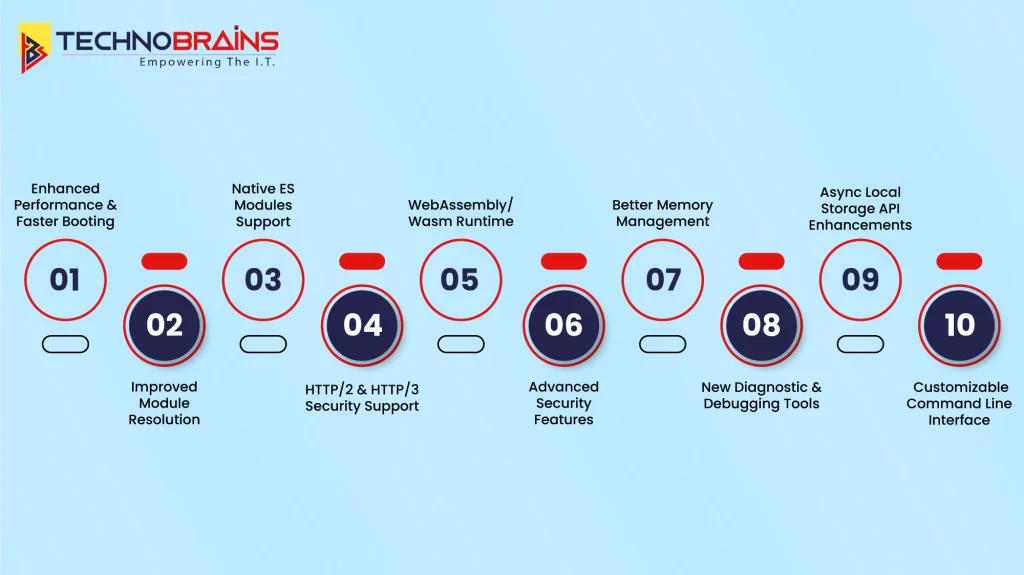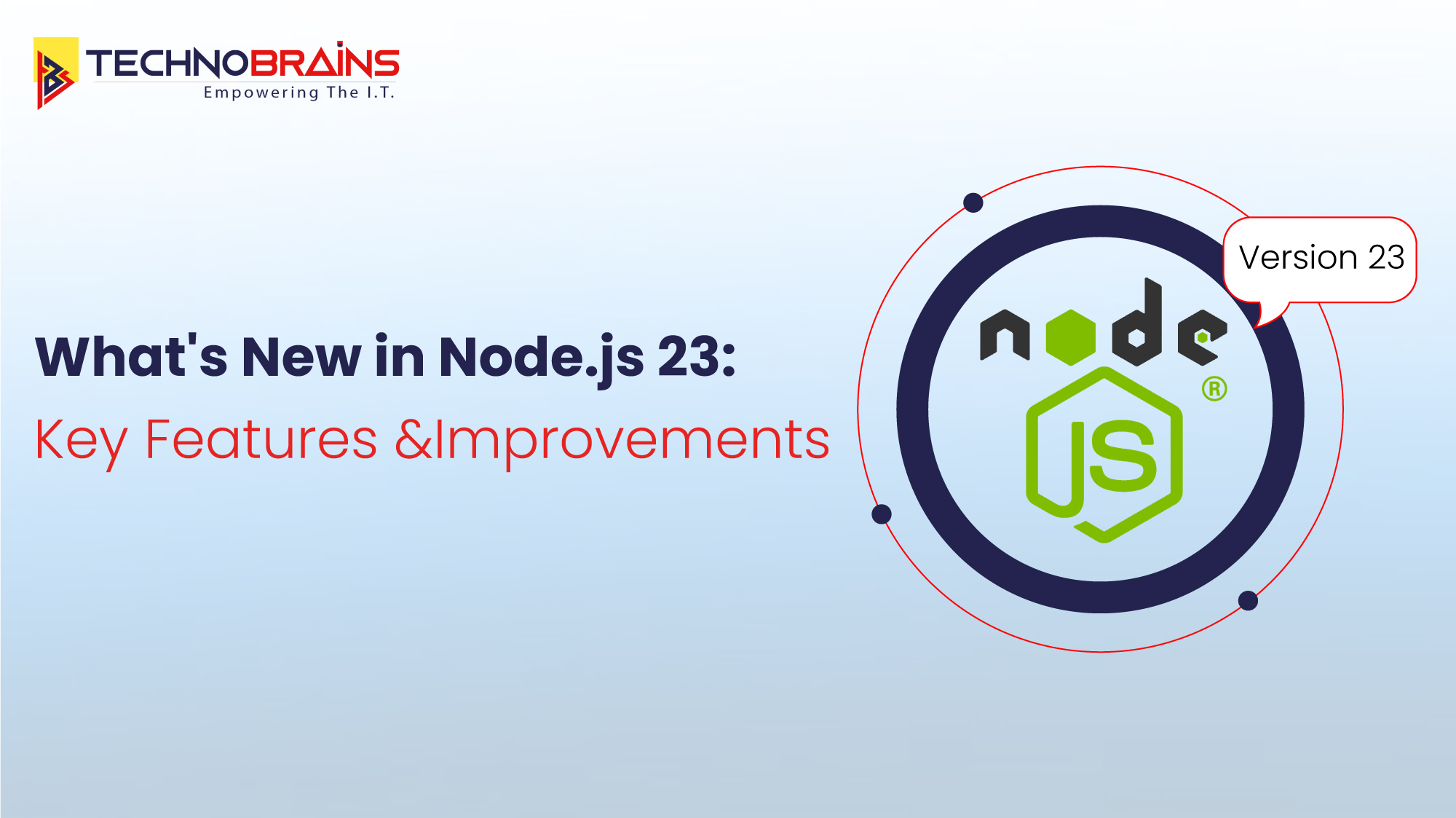The new release of Node.js is full of powerful upgrades, adding new features that will further enhance your application development. Whether creating new applications or improving existing ones, now is the best time to learn what’s new in Node.js 23. Let’s take a look at the Node.js 23: New Features, which you have to know about their integration into Node.js development services:

1. Enhanced Performance and Faster Booting
Node.js 23 has improved startup time because there was some optimization in the V8 engine. That will be very useful for projects where speed and scalability are important.
- Faster Loading: Optimizations in the JavaScript Engine result in speedier code execution.
- Optimized Garbage Collection: Memory usage is lower, and resources can be better managed.
- The main advantages include Efficient Resource Allocation: Improvements let applications execute smoothly with reduced latency.
2. Improved Module Resolution
The new Node.js 23 brings along an enhanced module resolution process, one of the most awaited features in this latest version. This update guarantees managing code organization and dependencies.
- Simpler Imports: Smart methods of referring to modules will reduce code bloat.
- Better error Handling: debugging is easier due to more explicit, yet concise error messages.
- Optimized code Sharing: It assists developers in sharing common modules between different projects more effectively and efficiently.
Read also, Upgrading Node.js to the Latest Version: An In-Depth Tutorial
3. Native ES Modules Support
Among many other node js updates, the services now natively provide support for ES modules, which facilitates code compatibility by standardizing the imports of modules.
- Unified import/export Syntax: No more “require” syntax inconsistencies.
- Improved Interoperability: Interoperate seamlessly with front-end code bases.
- Standardized across Environments: Allows Node.js code to be more portable across other JavaScript environments.
4. HTTP/2 and HTTP/3 Security Support
Node.js 23 contains improved support for HTTP/2 and thus also introduces HTTP/3, making it easier for developers to provide fast and secure connections within their applications.
- Increased data Security: HTTP/3 support introduces advanced encryption that by default becomes a requirement.
- Reduced Latency: HTTP/2 optimizations offer quicker response times for applications.
- Seamless Upgrades: HTTP/2 and HTTP/3 can be adopted with minimum changes to existing applications.
5. WebAssembly/Wasm Runtime out of the box
Node.js 23 allowed running Web Assembly modules natively, further extending the number of programming languages that could be used inside Node.js applications.
- Cross-system Sbility: Execution of code written in languages such as Rust, C, and C++.
- Improved Performance for Computation-Heavy Workloads: Wasm does way better on computation-heavy workloads.
- Wider Compatibility: Use libraries and tools that are not written in JavaScript.
6. Advanced Security Features
That being said, security is still paramount, and Node.js 23. introduces a raft of features designed to lock down applications against vulnerabilities.
- Runtime Security Check: Automatically detect common security risks in real-time.
- Better Dependency Management: Newer policies have lesser chances of third-party vulnerabilities.
- Improved Code Signing: It will help pay attention to the integrity of the code by making sure it is tamper-free.
7. Better Memory Management
Node.js 23 provides a number of new memory management improvements that reduce the memory footprint, and make large-scale applications run more stably.
- Automatic Memory Management: Memory now dynamically gets allocated concerning any particular workload.
- Efficient Garbage Collection: Smoother operation due to improved garbage collection.
- Reduced Memory Leaks: better handling of applications running for a long time that prevents memory leaks.
8. New Diagnostic and Debugging Tools
Debugging Node.js is much easier in Node.js 23, due to newly integrated tools that will help developers identify and fix issues with great efficiency.
- Advanced logging capabilities to better correlate runtime errors and code behaviour.
- Error Code Details More informative error messages for faster debugging.
- Built-in performance profiling identifies bottlenecks as they occur.
9. Async Local Storage API Enhancements
The Async Local Storage API has been curated with support for modern asynchronous JavaScript patterns.
- Improved error Tracking: It enables the tracing of errors across asynchronous calls for improved handling.
- Persistence of data across Requests: Ensures continuity of data even with asynchronous environments.
- Simplified Transactional Management: This is useful for applications with multi-threaded requests.
10. Customizable Command Line Interface
Node.js 23 brings a more flexible and user-friendly CLI that can be adjusted by developers in accordance with their needs and workflow.
- New commands: it’s easier for script execution. Simplified command management.
- Better Configuration Options: personalized commands according to the very needs of a particular project.
- Smoother Automation: Extend the running of scripts and improvement of tools using CLI enhancements.
Read also, What’s New in .NET 9: Latest Features and Release Date
Conclusion
Ranging from new features in Node.js 23 to better compatibility, updates are one of the most competitive steps forward in the evolution of JavaScript on the server to this date. It will help you make robust and efficient applications to fit today’s demands, whether you target Web development, mobile applications, or even complex server environments.
If you are looking for incredible Node.js Development Services then contact TechnoBrains.









